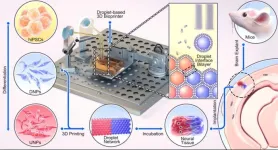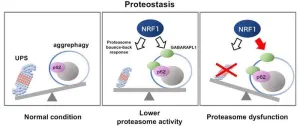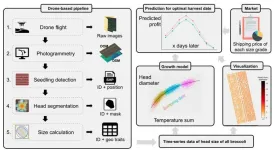(Press-News.org) Researchers have produced an engineered tissue representing a simplified cerebral cortex by 3D printing human stem cells.
When implanted into mouse brain slices, the structures became integrated with the host tissue.
The technique may ultimately be developed into tailored repairs to treat brain injuries.
A breakthrough technique developed by University of Oxford researchers could one day provide tailored repairs for those who suffer brain injuries. The researchers demonstrated for the first time that neural cells can be 3D printed to mimic the architecture of the cerebral cortex. The results have been published today in the journal Nature Communications.
Brain injuries, including those caused by trauma, stroke and surgery for brain tumours, typically result in significant damage to the cerebral cortex (the outer layer of the human brain), leading to difficulties in cognition, movement and communication. For example, each year, around 70 million people globally suffer from traumatic brain injury (TBI), with 5 million of these cases being severe or fatal. Currently, there are no effective treatments for severe brain injuries, leading to serious impacts on quality of life.
Tissue regenerative therapies, especially those in which patients are given implants derived from their own stem cells, could be a promising route to treat brain injuries in the future. Up to now, however, there has been no method to ensure that implanted stem cells mimic the architecture of the brain.
In this new study, the University of Oxford researchers fabricated a two-layered brain tissue by 3D printing human neural stem cells. When implanted into mouse brain slices, the cells showed convincing structural and functional integration with the host tissue.
Lead author Dr Yongcheng Jin (Department of Chemistry, University of Oxford) said: ‘This advance marks a significant step towards the fabrication of materials with the full structure and function of natural brain tissues. The work will provide a unique opportunity to explore the workings of the human cortex and, in the long term, it will offer hope to individuals who sustain brain injuries.’
The cortical structure was made from human induced pluripotent stem cells (hiPSCs), which have the potential to produce the cell types found in most human tissues. A key advantage of using hiPSCs for tissue repair is that they can be easily derived from cells harvested from patients themselves, and therefore would not trigger an immune response.
The hiPSCs were differentiated into neural progenitor cells for two different layers of the cerebral cortex, by using specific combinations of growth factors and chemicals. The cells were then suspended in solution to generate two ‘bioinks’, which were then printed to produce a two-layered structure. In culture, the printed tissues maintained their layered cellular architecture for weeks, as indicated by the expression of layer-specific biomarkers.
When the printed tissues were implanted into mouse brain slices, they showed strong integration, as demonstrated by the projection of neural processes and the migration of neurons across the implant-host boundary. The implanted cells also showed signalling activity, which correlated with that of the host cells. This indicates that the human and mouse cells were communicating with each other, demonstrating functional as well as structural integration.
The researchers now intend to further refine the droplet printing technique to create complex multi-layered cerebral cortex tissues that more realistically mimic the human brain’s architecture. Besides their potential for repairing brain injuries, these engineered tissues might be used in drug evaluation, studies of brain development, and to improve our understanding of the basis of cognition.
The new advance builds on the team’s decade-long track record in inventing and patenting 3D printing technologies for synthetic tissues and cultured cells.
Senior author Dr Linna Zhou (Department of Chemistry, University of Oxford) said: ‘Our droplet printing technique provides a means to engineer living 3D tissues with desired architectures, which brings us closer to the creation of personalized implantation treatments for brain injury.’
Senior author Associate Professor Francis Szele (Department of Physiology, Anatomy and Genetics, University of Oxford) added: ‘The use of living brain slices creates a powerful platform for interrogating the utility of 3D printing in brain repair. It is a natural bridge between studying 3D printed cortical column development in vitro and their integration into brains in animal models of injury.’
Senior author Professor Zoltán Molnár (Department of Physiology, Anatomy and Genetics, University of Oxford) said: ‘Human brain development is a delicate and elaborate process with a complex choreography. It would be naïve to think that we can recreate the entire cellular progression in the laboratory. Nonetheless, our 3D printing project demonstrates substantial progress in controlling the fates and arrangements of human iPSCs to form the basic functional units of the cerebral cortex.'
Senior author Professor Hagan Bayley (Department of Chemistry, University of Oxford) said: ‘This futuristic endeavour could only have been achieved by the highly multidisciplinary interactions encouraged by Oxford's Martin School, involving both Oxford's Department of Chemistry and the Department of Physiology, Anatomy and Genetics.’
Notes for editors:
For media inquiries and interviews, contact:
Professor Hagan Bayley
hagan.bayley@chem.ox.ac.uk
+44 7780 607457
The study ‘Integration of 3D-Printed Cerebral Cortical Tissue into an ex vivo Lesioned Brain Slice’ will be published in Nature Communications at 10:00 AM BST/ 05:00 AM ET Wednesday 04 October, 2023 at https://www.nature.com/articles/s41467-023-41356-w. To view a copy of the manuscript under embargo, contact Dr Caroline Wood: caroline.wood@admin.ox.ac.uk
The research was supported by a European Research Council Advanced Grant (SYNTISU) and the Oxford Martin School Programme on 3D Printing for Brain Repair.
About the University of Oxford
Oxford University has been placed number 1 in the Times Higher Education World University Rankings for the eighth year running, and number 3 in the QS World Rankings 2024. At the heart of this success are the twin-pillars of our ground-breaking research and innovation and our distinctive educational offer.
Oxford is world-famous for research and teaching excellence and home to some of the most talented people from across the globe. Our work helps the lives of millions, solving real-world problems through a huge network of partnerships and collaborations. The breadth and interdisciplinary nature of our research alongside our personalised approach to teaching sparks imaginative and inventive insights and solutions.
Through its research commercialisation arm, Oxford University Innovation, Oxford is the highest university patent filer in the UK and is ranked first in the UK for university spinouts, having created more than 300 new companies since 1988. Over a third of these companies have been created in the past five years. The university is a catalyst for prosperity in Oxfordshire and the United Kingdom, contributing £15.7 billion to the UK economy in 2018/19, and supports more than 28,000 full time jobs.
END
Oxford researchers develop 3D printing method that shows promise for repairing brain injuries
2023-10-04
ELSE PRESS RELEASES FROM THIS DATE:
Tracking the bacteria behind life-threatening sepsis in premature babies
2023-10-04
Premature babies in neonatal care units are extremely vulnerable, and susceptible to life-threatening infections. To help keep these babies safe the risk of infection needs to be kept as low as possible.
A particular problem is late onset sepsis that starts from three days after birth, when bacteria get into the blood and grow. This can be very dangerous and babies with late onset sepsis end up staying in hospital longer, need more treatment with antibiotics and can be left with life-long effects on their health.
Bacteria from the Staphylococcus family are the most common causes ...
Intervention for caregivers helps prevent elder mistreatment
2023-10-04
An educational and social support intervention for caregivers reduced elder mistreatment of older adults with chronic illness, including dementia. That’s the result of a recent double-blind, randomized controlled trial published in the Journal of the American Geriatrics Society.
Elder mistreatment is defined as “an intentional act or failure to act by a caregiver or another person in a relationship involving an expectation of trust that causes or creates a risk of harm to an older adult.” Through the Comprehensive Older Adult and Caregiver Help (COACH) intervention tested in this trial, coaches met with caregivers weekly for up to 12 sessions to listen to their ...
Does COVID-19 or COVID-19 vaccination worsen migraines?
2023-10-04
Research published in the European Journal of Neurology indicates that COVID-19 and COVID-19 vaccination have negligible effects on migraine severity.
Among 550 adults who had received migraine-related care at a Spanish headache clinic, 44.9% (247) reported COVID-19 at least once and 83.3% (458) had been vaccinated; 61 patients (24.7%) reported migraine worsening since COVID-19 and 52 (11.4%) since vaccination.
In participants who perceived that their migraines worsened, those who had been infected were 2.5-times more ...
Are opioid prescription rates changing for US adolescents?
2023-10-04
A new analysis reveals that rates of opioid prescribing to US adolescents have decreased in recent years, primarily limited to non-surgery indications. Opioid prescription rates for surgery have remained stable.
The analysis, which is published in Pediatric Anesthesia, assessed data from the 2015–2020 Medical Expenditure Panel Surveys, which are nationally representative, large-scale surveys conducted annually by the Agency for Healthcare Research and Quality.
Among 26,909 children aged 10–19 years, 4.7% underwent a surgical procedure in 2015–2020. ...
Can public financing for political campaigns affect voter participation?
2023-10-04
Policies that provide public financing for political campaigns have gained popularity in the United States. One example is the Democracy Vouchers program that was implemented in Seattle, Washington in 2017 to potentially reduce candidates' reliance on large donations. Research published in Contemporary Economic Policy studied the effects of this program on voter registration and turnout.
In Seattle’s Democracy Vouchers program, every registered voter in the city receives $100 worth of publicly funded vouchers to donate to candidates for municipal office, and candidates ...
Study reveals novel therapeutic target to eliminate unwanted and misfolded proteins
2023-10-04
Biological cells contain in-built "housekeeping" mechanisms for taking care of damaged cellular structures. This includes the ubiquitin‒proteasome system (UPS), which selectively tags unwanted proteins with the ubiquitin molecule, and then clears them. When the UPS mechanism fails, cells activate a compensatory protein clearance process called "aggrephagy," in which protein aggregates are degraded by the cell in a controlled manner. However, thus far, the mechanism behind aggrephagy has been unknown.
Now, a landmark paper published on 1 September ...
Women living in more walkable neighborhoods have lower rates of obesity-related cancers
2023-10-04
Residing in a more walkable neighborhood protects against the risk of overall obesity-related cancers in women, specifically postmenopausal breast cancer, but also ovarian cancer, endometrial cancer, and multiple myeloma, according to a new study by Columbia University Mailman School of Public Health and NYU Grossman School of Medicine. Obesity has been linked to increased risk for 13 types of cancer in women, and physical activity, independent of body size, lowers risk for some of these cancers. Neighborhood walkability ...
Extreme fires and heavy rainfall driving platypuses from their homes
2023-10-04
Australia’s emerging pattern of severe mega bushfires and heavy rainfall may be driving platypuses from their homes, a new study by University of Melbourne researchers has shown.
Analysis of platypus DNA in rivers and creek water samples collected before and after the Black Summer 2019-2020 megafires suggest Australia’s beloved semi-aquatic monotremes might be abandoning severely bushfire-affected areas for up to 18 months after a fire, especially if heavy rainfall has followed the fire.
The study uses the recent technique of environmental DNA sampling, where animal DNA is collected from water, soil, air, or snow ...
Antigen testing can reduce, but not eliminate, the risk of COVID-19 clusters according to mathematical model
2023-10-04
A research group has created a new model to calculate the probability of the occurrence of localized clusters caused by novel coronavirus infections. Led by Shingo Iwami at Nagoya University with collaborators in the United Kingdom and South Korea model, they revealed that screening of infected persons by antigen testing is effective in significantly reducing the probability of cluster occurrence. However, their findings also suggest that it is not sufficient to prevent clusters caused by highly infectious mutant strains, such as Omicron.
With the availability of COVID-19 vaccines and population immunity, countries around the world are seeking to ...
AI drones to help farmers optimize vegetable yields
2023-10-04
For reasons of food security and economic incentive, farmers continuously seek to maximize their marketable crop yields. As plants grow inconsistently, at the time of harvesting, there will inevitably be variations in quality and size of individual crops. Finding the optimal time to harvest is therefore a priority for farmers. A new approach making heavy use of drones and artificial intelligence demonstrably improves this estimation by carefully and accurately analyzing individual crops to assess their likely growth characteristics.
Some optimistic science fiction stories talk about a post-scarcity future, where human needs are catered for and hard labor ...




